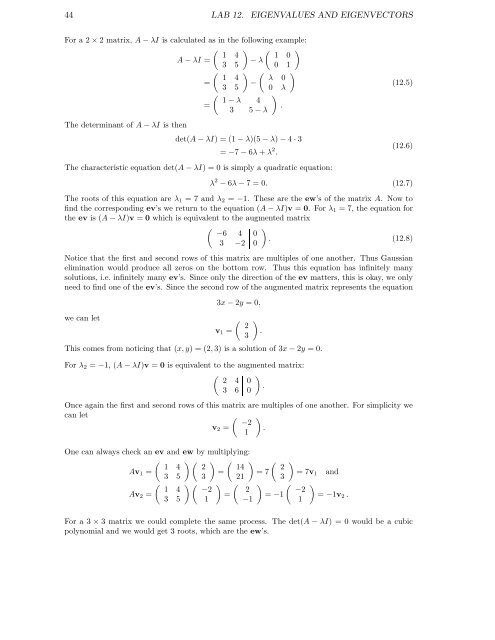Introduction to Numerical Math and Matlab ... - Ohio University
Introduction to Numerical Math and Matlab ... - Ohio University
Introduction to Numerical Math and Matlab ... - Ohio University
Create successful ePaper yourself
Turn your PDF publications into a flip-book with our unique Google optimized e-Paper software.
44 LAB 12. EIGENVALUES AND EIGENVECTORS<br />
For a 2 × 2 matrix, A − λI is calculated as in the following example:<br />
( ) ( )<br />
1 4 1 0<br />
A − λI = − λ<br />
3 5 0 1<br />
( ) ( )<br />
1 4 λ 0<br />
= −<br />
3 5 0 λ<br />
( )<br />
1 − λ 4<br />
=<br />
.<br />
3 5 − λ<br />
The determinant of A − λI is then<br />
det(A − λI) = (1 − λ)(5 − λ) − 4 · 3<br />
= −7 − 6λ + λ 2 .<br />
The characteristic equation det(A − λI) = 0 is simply a quadratic equation:<br />
(12.5)<br />
(12.6)<br />
λ 2 − 6λ − 7 = 0. (12.7)<br />
The roots of this equation are λ 1 = 7 <strong>and</strong> λ 2 = −1. These are the ew’s of the matrix A. Now <strong>to</strong><br />
find the corresponding ev’s we return <strong>to</strong> the equation (A − λI)v = 0. For λ 1 = 7, the equation for<br />
the ev is (A − λI)v = 0 which is equivalent <strong>to</strong> the augmented matrix<br />
( −6 4 0<br />
3 −2 0<br />
)<br />
. (12.8)<br />
Notice that the first <strong>and</strong> second rows of this matrix are multiples of one another. Thus Gaussian<br />
elimination would produce all zeros on the bot<strong>to</strong>m row. Thus this equation has infinitely many<br />
solutions, i.e. infinitely many ev’s. Since only the direction of the ev matters, this is okay, we only<br />
need <strong>to</strong> find one of the ev’s. Since the second row of the augmented matrix represents the equation<br />
we can let<br />
3x − 2y = 0,<br />
( 2<br />
v 1 =<br />
3<br />
This comes from noticing that (x, y) = (2, 3) is a solution of 3x − 2y = 0.<br />
For λ 2 = −1, (A − λI)v = 0 is equivalent <strong>to</strong> the augmented matrix:<br />
( )<br />
2 4 0<br />
.<br />
3 6 0<br />
Once again the first <strong>and</strong> second rows of this matrix are multiples of one another. For simplicity we<br />
can let<br />
( )<br />
−2<br />
v 2 = .<br />
1<br />
One can always check an ev <strong>and</strong> ew by multiplying:<br />
( ) ( ) ( ) ( )<br />
1 4 2 14 2<br />
Av 1 =<br />
= = 7 = 7v<br />
3 5 3 21 3 1 <strong>and</strong><br />
( ) ( ) ( ) ( )<br />
1 4 −2 2 −2<br />
Av 2 =<br />
= = −1 = −1v<br />
3 5 1 −1 1 2 .<br />
For a 3 × 3 matrix we could complete the same process. The det(A − λI) = 0 would be a cubic<br />
polynomial <strong>and</strong> we would get 3 roots, which are the ew’s.<br />
)<br />
.
















